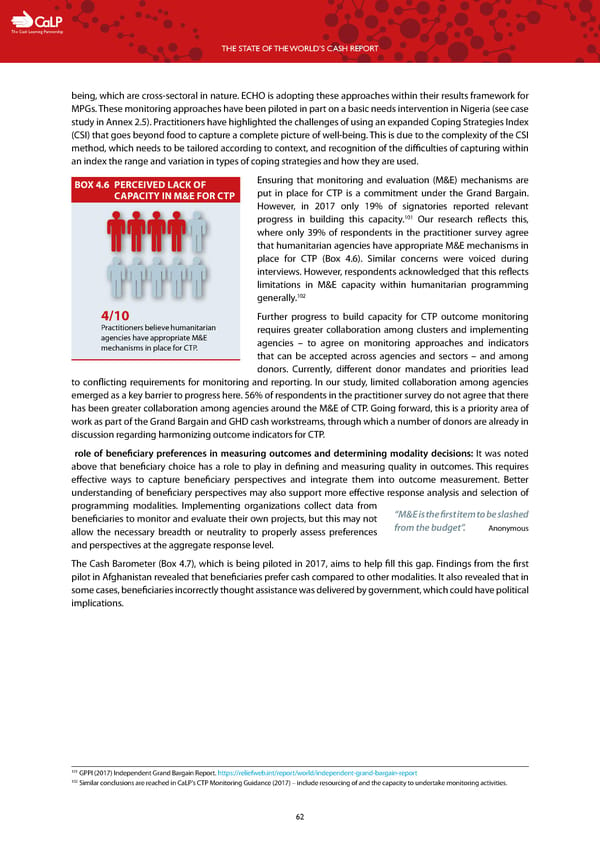C The Cash Learning Partnership THE STATE OF THE WORLD’S CASH REPORT being, which are cross-sectoral in nature. ECHO is adopting these approaches within their results framework for MPGs. These monitoring approaches have been piloted in part on a basic needs intervention in Nigeria (see case study in Annex 2.5). Practitioners have highlighted the challenges of using an expanded Coping Strategies Index (CSI) that goes beyond food to capture a complete picture of well-being. This is due to the complexity of the CSI method, which needs to be tailored according to context, and recognition of the difficulties of capturing within an index the range and variation in types of coping strategies and how they are used. BOX 4.6 PERCEIVED LACK OF Ensuring that monitoring and evaluation (M&E) mechanisms are CAPACITY IN M&E FOR CTP put in place for CTP is a commitment under the Grand Bargain. However, in 2017 only 19% of signatories reported relevant 101 progress in building this capacity. Our research reflects this, where only 39% of respondents in the practitioner survey agree that humanitarian agencies have appropriate M&E mechanisms in place for CTP (Box 4.6). Similar concerns were voiced during interviews. However, respondents acknowledged that this reflects limitations in M&E capacity within humanitarian programming 102 generally. 4/10 Further progress to build capacity for CTP outcome monitoring Practitioners believe humanitarian requires greater collaboration among clusters and implementing agencies have appropriate M&E agencies – to agree on monitoring approaches and indicators mechanisms in place for CTP. that can be accepted across agencies and sectors – and among donors. Currently, different donor mandates and priorities lead to conflicting requirements for monitoring and reporting. In our study, limited collaboration among agencies emerged as a key barrier to progress here. 56% of respondents in the practitioner survey do not agree that there has been greater collaboration among agencies around the M&E of CTP. Going forward, this is a priority area of work as part of the Grand Bargain and GHD cash workstreams, through which a number of donors are already in discussion regarding harmonizing outcome indicators for CTP. role of beneficiary preferences in measuring outcomes and determining modality decisions: It was noted above that beneficiary choice has a role to play in defining and measuring quality in outcomes. This requires effective ways to capture beneficiary perspectives and integrate them into outcome measurement. Better understanding of beneficiary perspectives may also support more effective response analysis and selection of programming modalities. Implementing organizations collect data from “M&E is the first item to be slashed beneficiaries to monitor and evaluate their own projects, but this may not from the budget”. Anonymous allow the necessary breadth or neutrality to properly assess preferences and perspectives at the aggregate response level. The Cash Barometer (Box 4.7), which is being piloted in 2017, aims to help fill this gap. Findings from the first pilot in Afghanistan revealed that beneficiaries prefer cash compared to other modalities. It also revealed that in some cases, beneficiaries incorrectly thought assistance was delivered by government, which could have political implications. 101 GPPI (2017) Independent Grand Bargain Report. https://reliefweb.int/report/world/independent-grand-bargain-report 102 Similar conclusions are reached in CaLP’s CTP Monitoring Guidance (2017) – include resourcing of and the capacity to undertake monitoring activities. 62
 The State of the World's Cash | Full Report Page 63 Page 65
The State of the World's Cash | Full Report Page 63 Page 65